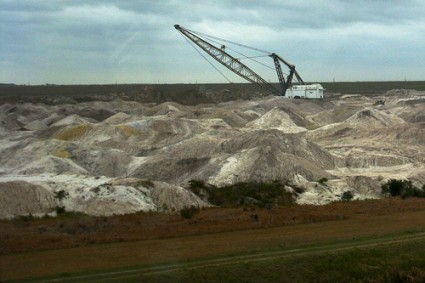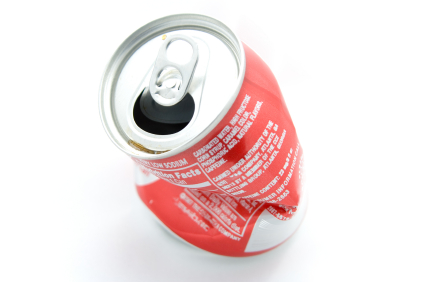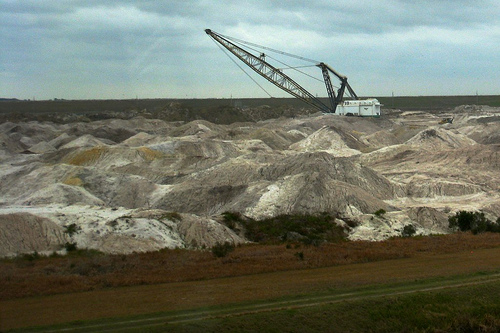 Where your food comes from: a phosphate mine in Florida run by the fertilizer giant Mosaic. Mosaic is two-thirds owned by Cargill, the globe’s largest agribusiness company, with interests in meat, feed, biofuels, and more. Photo: Susan Dracket, via FlickrAs Grist’s recent special series showed, our reliance on synthetic nitrogen fertilizer has serious ecological, geopolitical, public-health, and agricultural consequences.
Where your food comes from: a phosphate mine in Florida run by the fertilizer giant Mosaic. Mosaic is two-thirds owned by Cargill, the globe’s largest agribusiness company, with interests in meat, feed, biofuels, and more. Photo: Susan Dracket, via FlickrAs Grist’s recent special series showed, our reliance on synthetic nitrogen fertilizer has serious ecological, geopolitical, public-health, and agricultural consequences.
Yet N isn’t our only fertilizer problem. To grow robustly, plants need sufficient access to three key macronutrients: N,P, and K, or nitrogen, phosphorous, and potassium.
In non-industrial and organic farming systems, recycling these nutrients is a paramount task. Think compost, which harvests the nutrients in plant waste and returns them to the soil–along with a nice dash of soil-building organic matter. In industrial ag, the idea is to introduce huge new amounts of isolated NPK every growing season.
One main problem with N, of course, is that isolating it in a form plants can use is incredibly energy intensive. Here in the United States, the globe’s most voracious per-capita user of N, we rely on natural gas as our main fuel for N production–even though natural gas is increasingly scarce and harvesting it is increasingly ecologically devastating. (In China, the world’s largest overall user of N, they rely mainly on coal for N production: a chilling fact to consider.)
While N production consumes massive amounts of fossil energy, the other two main fertilizer elements, phosphorous and potassium, are literally mined. Thus, like our transportation system, our food system depends on finite resources.
Think about that next time you hear someone call ethanol made from industrial corn–far and away our biggest gulper of N, P, and K–a “renewable fuel.” It’s also worth remembering when some industry hack or USDA chieftain insists that industrial agriculture is the only way to “feed the world.” “Oh, yeah?” you should reply; “for how long?”
From what I can tell, potassium–known as potash in its fertilizer form–isn’t in short supply. (It should be noted, however, that when fertilizer prices spiked in 2008, industrial-ag powerhouse Brazil was considering cutting through “environmental red tape” to mine potassium under the Amazon rainforest.)
Unfortunately, though, phosphorous is in short supply, as recent articles in Foreign Policy and Der Spiegel make clear.
Here’s Foreign Policy:
By 2008, industrial farmers were applying an annual 17 million metric tons of mined phosphorus on their fields. Demand is expanding at around 3 percent a year — a rate that is likely to accelerate due to rising prosperity in the developing world (richer people consume more meat) and the burgeoning bioenergy sector, which also requires phosphorus to support crop-based biofuels.
But there’s a problem….
Our supply of mined phosphorus is running out. Many mines used to meet this growing demand are degrading, as they are increasingly forced to access deeper layers and extract a lower quality of phosphate-bearing rock (phosphate is the chemical form in which nearly all phosphorus is found). Some initial analyses from scientists with the Global Phosphorus Research Initiative estimate that there will not be sufficient phosphorus supplies from mining to meet agricultural demand within 30 to 40 years.
Moreover, like oil, mine-friendly phosphate rock is geographically concentrated–indeed, even more so than petroleum.
Nearly 90 percent of the world’s estimated phosphorus reserves are found in five countries: Morocco, China, South Africa, Jordan, and the United States. In comparison, the 12 countries that make up the OPEC cartel control only 75 percent of the world’s oil reserves.
Already, geopolitical tensions are rising. Morocco is the site of 37 percent of the globe’s known phosphate rock reserves. Not a great situation, FP observes:
Many of Morocco’s phosphate mines are in Western Sahara, a disputed independent territory that is occupied by Morocco and the site of growing international human rights concerns. Reflecting these concerns, U.N.-sanctioned export restrictions on phosphate and other resources are now in place, though the efficacy of the bans is incomplete.
During the global food crisis in 2008, China–which also has large phosphate reserves–banned exports of the key fertilizer ingredient. As phosphorous prices rise and supplies tighten, you can expect nations with reserves to impose high prices–or even, as China did, hoard supplies.
One additional problem that neither Foreign Policy or Der Spiegel mention: phosphorous mining, at least in Florida, is an ecologically devastating process that leaves behind, um … radioactive waste. I wrote a post on this very topic back in 2008. Get this:
For every ton of raw fertilizer produced, the industry generates five tons of phosphogypsum, a radioactive material the U.S. Environmental Agency considers hazardous waste. With limited options available, the phosphate industry is storing more than a billion tons of phosphogypsum in stacks that tower up to 200 feet high — a problem that grows by 30 million tons every year.
You really should read that post. It’s all about the environmental nightmare of phosphate mining; and the EPA’s sad inability to enforce even its own lax standards around it. There’s some good ol’ fashioned political cronyism in there, too. And a huge Cargill angle!
So what to do? Of course, I would call for a shift to organic farming–organized efforts to conserve and recycle nutrients through composting programs. Subsidies could be reconfigured to reward farmers for reducing fertilizer use (they are now rewarded for gross output–giving them incentive to overapply fertilizer to maximize yields); municipalities and regions could ramp up composting programs and find efficient ways to get that compost back to farms.
And potentially, the toxicity problems with human waste could be resolved; and the vast amount of valuable nutrients now flushed into sewers could be returned to fields. Right now, our phosphorous- and nitrogen-rich waste is mixed with all manner of industrial effluent and turned into a vile substance called “sludge” (or, to use the industry’s preferred phrase, “biosolids”). But if it could be kept separate from industrial waste and composted in a way that truly takes care of pathogens and other nasties, it could become an excellent resource. As the 19th century French novelist Victor Hugo memorably put it (lifted from the Der Spiegel piece), “There is no guano comparable in fertility to the detritus of a capital.”
Well, I don’t make policy–I just comment on it. Policymakers have of course not grappled much with the fertilizer problem. Der Spiegel points to a pilot project in Austria, operating on the site of an underused fertilizer plant near a now-depleted phosphorous mine. (Europe, it should be noted, imports nearly 100 percent of its phosphorous. Thus the rigors of “peak phosphorous” already haunt the Continent.) Someone has had the idea of refining sewage sludge from Vienna to extract its phosphorous.
When it is delivered to the pilot plant, the sewage sludge ash is unfit for use as a fertilizer, because it contains excessively high levels of heavy metals like cadmium. As gears groan and conveyor belts squeak, the ash, combined with chemical additives, is moved into a rotary kiln, where a hissing natural gas flame heats it to 1,000 degrees Celsius (1,832 degrees Fahrenheit). After half an hour in the rotary kiln, the ash, which has now passed through two purification steps, has a phosphate content of about 16 percent. It is then enriched with other plant nutrients, like potassium and nitrogen, to yield the final product: urban fertilizer. [Emphasis mine.]
Ah, another fossil-fuel (and chemical-) intensive process. Moving toward a food system that recycles nutrients–honoring what the organic-farming pioneer Sir Albert Howard called the “law of return”–will be difficult. But finding industrial means that truly solve our fertilizer problem may prove more vexing still.




